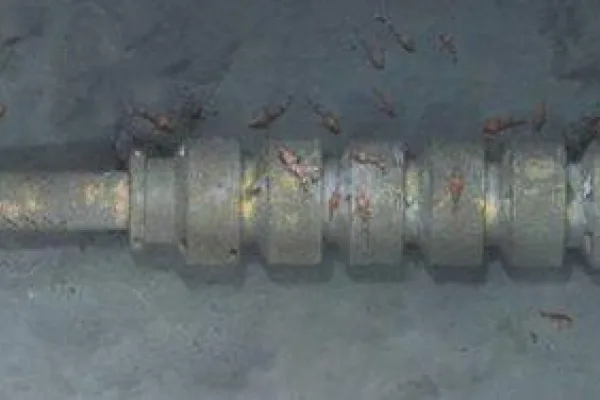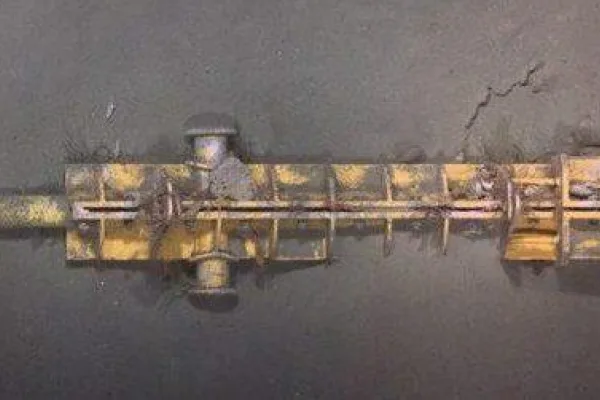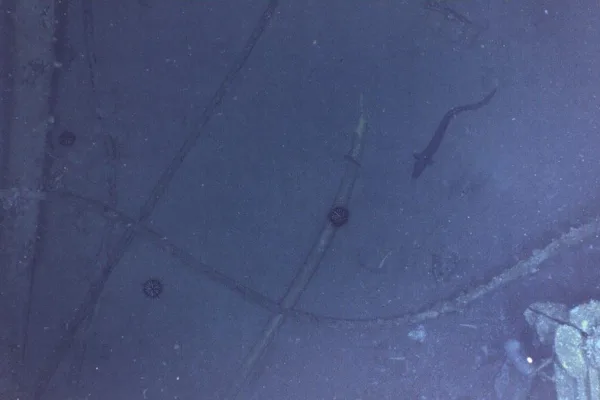Basker Manta Gummy (BMG) Closure Project Phase 2 Environment Plan (Update)
The Basker Manta Gummy (BMG) Closure Project Phase 2 Environment Plan was accepted by the regulator, the National Offshore Petroleum Safety and Environment Management Authority (NOPSEMA), in 2024. We will update and resubmit the Environment Plan to NOPSEMA in 2026 to reflect an updated activity window. The window for execution of the offshore activity is being revised in the Environment Plan to reflect the current planned and expected timing for the remaining offshore works with a construction vessel.
A reminder of the scope: the Phase 2 Environment Plan provides for the recovery of all equipment from the seabed, except for components that cannot be removed, including some well components and a steel pile below the seabed. The updated Environment Plan will provide for the same activities.
Here is the current BMG Ph 2 Environment Plan.
Update log
- September 2025: Page created
Location
50 km offshore Marlo, south of Orbost, Victoria, in Commonwealth waters.
Offshore Gunaikurnai Country.
Call for comments
We are preparing the Basker Manta Gummy Environment Plan update. If you think your functions, interests or activities may be affected, we would like to hear from you.
Meet with us
Please reach out to us directly if you would like to meet with us regarding the Basker Manta Gummy Environment Plan update.
This is the BMG Ph 2 Update Generic Mailout 1.
Activity details
We plan to:
- Prepare equipment for recovery from the seabed, making sure it can be lifted safely onto a construction vessel.
- Recover equipment from the seabed to the construction vessel.
- Conduct a clearance survey within the infrastructure footprint to ensure no debris remains.
Equipment used for these activities will include:
- Construction vessel with large crane and/winch or reel system.
- Remotely operated vehicles with video recorder and live link to vessel
- Cleaning, cutting and manipulation tools.
- Side scan sonar and / or sub-bottom profiler
- Multi-beam echosounder.
- Magnetometer.
Distance from shore
Approximately 50 km
Permit area
VIC/RL13
Water depth
Approximately 130m to 270m
Supply base
To be determined. Likely options include Barry Beach Marine Terminal, Eden or Geelong.
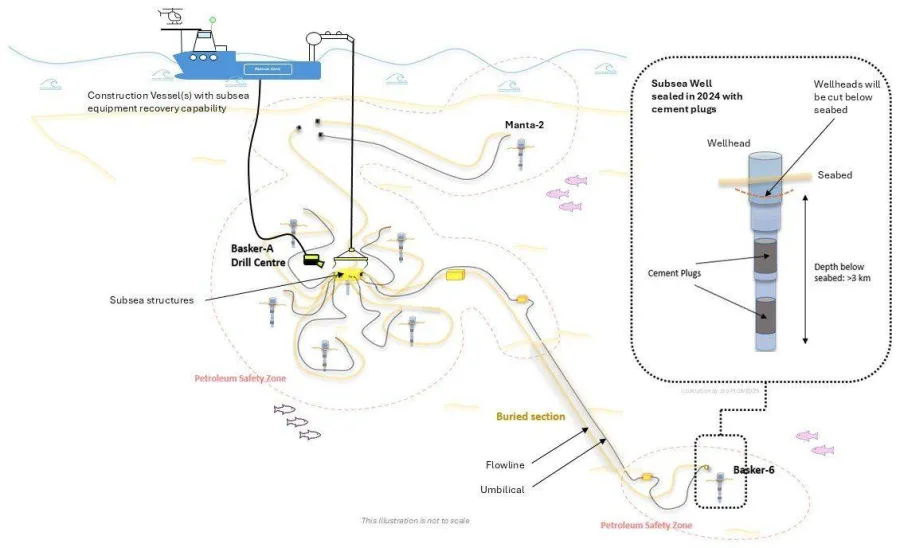
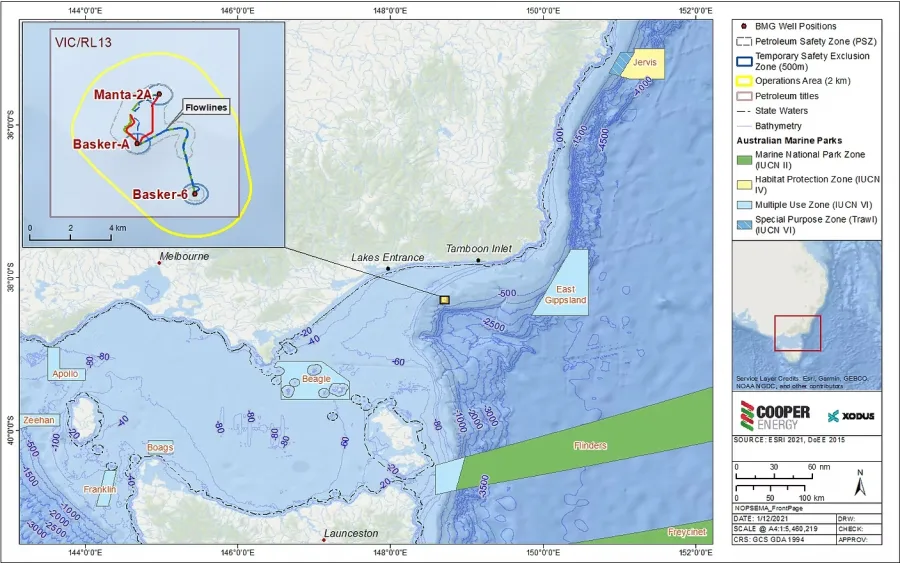
Summary of Impacts, Risks and Activities
Information sheet regarding impacts, risks and control measures.
Timeline
Offshore activities are planned to be carried out during the period 2026 to 2030, either as a single 50-day campaign, or multiple smaller campaigns. Weather delays can increase the overall time of the activity. Short (<7-day) vessel-campaigns may be required to check/maintain the integrity of the subsea equipment to ensure it can be removed.
Identified impacts and risks
By interest group
If you have concerns about how these may affect your functions, interests or activities, please contact us.
Find out about risks and impacts that may affect you.
Interaction with other marine users
- Construction vessel operations: Presence will be temporary with vessels mobilised from Barry Beach Marine Terminal, Eden or Geelong/Melbourne area
- There are Petroleum Safety Zones around the existing Basker Manta Gummy Equipment. This is a safety exclusion zone which cannot be entered without permission from the Titleholder. There will be a Caution Zone around the Contraction Vessel as it will have limited maneuverability.
Impacts
- Changes to the functions, interests and activities of other marine users
Controls
- Temporary Exclusion Zones will be communicated via Notice to Mariners
- Petroleum Safety Zone layout drawing and coordinates are Gazetted here: https://www.nopsema.gov.au/sites/default/files/2021-03/A443819.pdf
- Fisheries damages protocol is in place
- Ongoing consultation and notification with persons who require it
- Marine assurance process for the vessels we hire
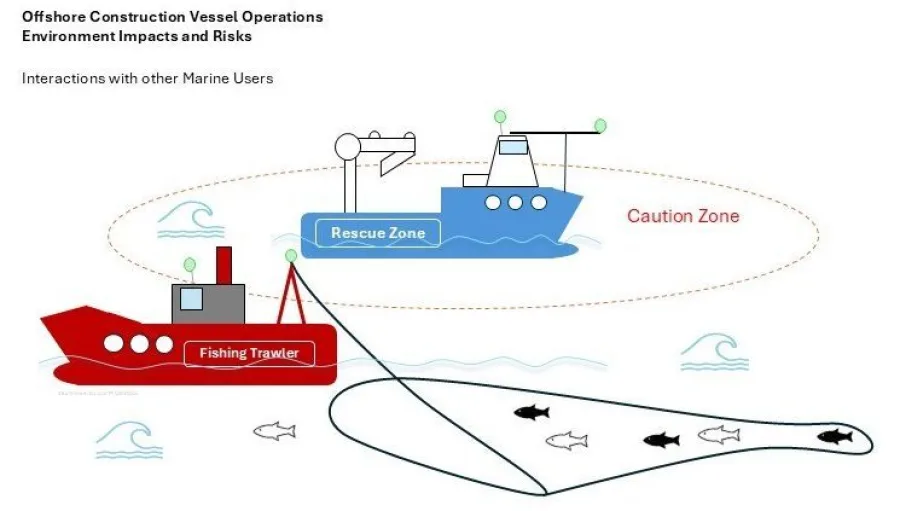
Seabed disturbance
Our proposed activities offshore include:
- Placing equipment on the seabed, such as baskets and frames, which we will load up with the equipment to be recovered from the seabed.
- Deburial and movement of equipment on the seabed to facilitate its recovery
- 'Flying' the Remotely Operated Vehicle close to seabed
- Deposition of fine materials to the seabed from cutting operations. This could grit and flocculant use to perform cuts, as well as steel, cement and plastic cuttings
Impact
- Change in benthic habitat
Risks
- Marine fauna injury or mortality
- Disturbance to cultural heritage
Controls
- Offshore work procedures to guide the safe recovery of equipment and prevent dropping equipment on the seabed.
- Marine assurance process for the vessels we hire to ensure they are suitable for the work scope and environmental conditions.
- Underwater cultural heritage disturbance risk management measures to avoid disturbing cultural heritage
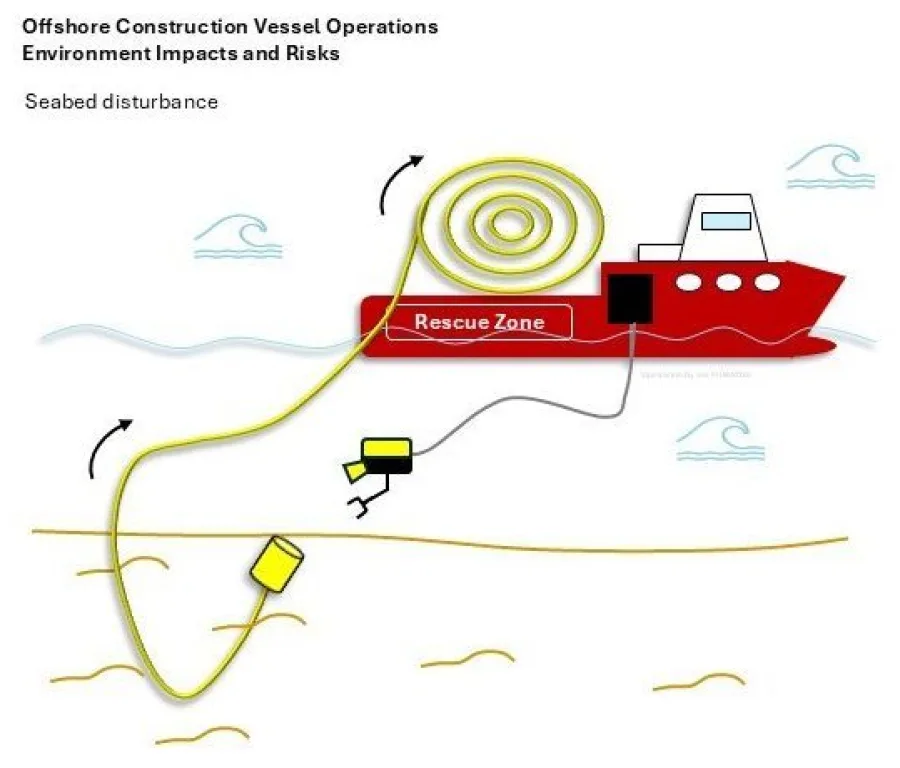
Underwater sound
Underwater sound will be generated from the following activities:
- Construction vessel operation: Continuous sound through propeller and thrusters when moving and holding position. Indicative support vessel is shown below.
- ROV operations (low level thrust)
- Vibrations from subsea tools (rotating and reciprocating equipment).
- Crew transfers to the construction vessel via helicopter
Impact
- Change in ambient sound
Risks
- Behavioural change in marine fauna (marine mammals, marine turtles, fish)
- Auditory impairment (marine fauna)
Controls
- Victoria Whale Disturbance Risk Management Procedure to ensure our activities are not inconsistent with relevant EPBC Act species recovery plans.
- Marine assurance process for the vessels we hire, ensuring they are suitable for the work scope and environmental conditions.
- Offshore work procedures to guide the safe use of equipment subsea.
Greenhouse gas emissions
Greenhouse Gas (GHG) emissions are generated by the following activities:
- Construction vessel operations: The vessel generates direct emissions by its use of hydrocarbons to generate power for operation. Indirect emissions are generated through the management of waste generated during the project.
Impacts
- Increase in greenhouse gas emissions
- Change in climate systems
- Change in ecosystems
- Change in Socio-economic factors
Controls
- Marine assurance process
- Emissions reduction protocol
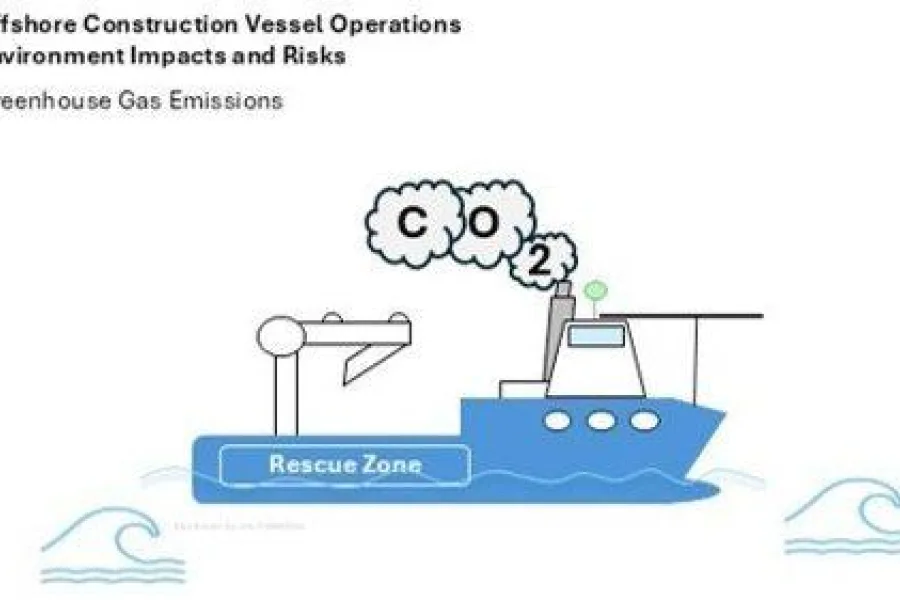
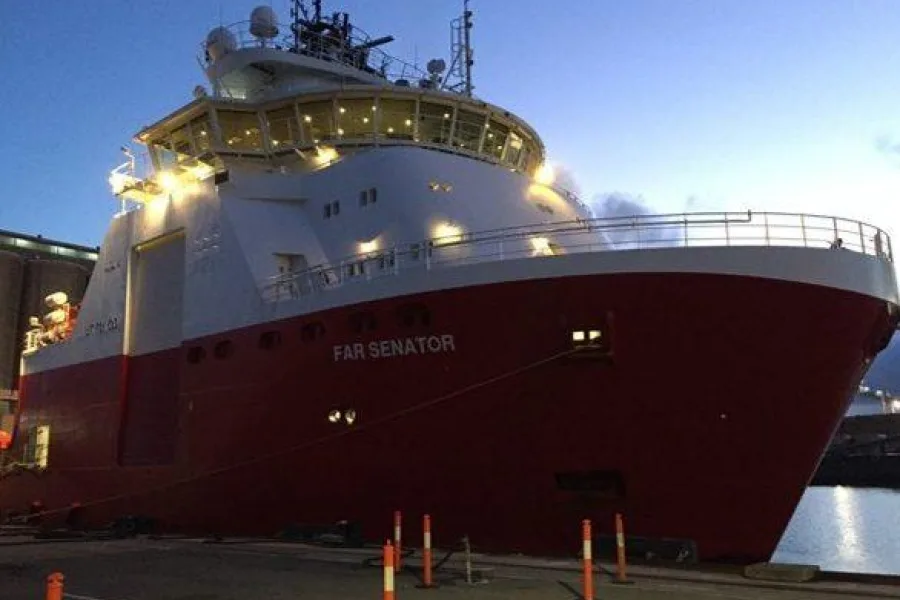
Light emissions
Our proposed activities offshore that will result in light emissions include:
- Vessel operations
Impact
- Change in ambient light
Risks
- Change in fauna behaviour
Controls
- Implement Marine Assurance Process to confirm compliance with Marine Order 30 associated with the prevention of collisions at sea. Given the location of the activity far from any coastlines, and the limited scale and duration of the activity no further measures are planned.
Other atmospheric emissions
Our proposed activities offshore that will result in Atmospheric Emissions include:
- Vessel operations
- Helicopter operations
Impact
- Change in air quality
Controls
- Implement a Marine Assurance Process for vessels to confirm the vessels compliance with standard emissions management practices required under the International Convention for the Prevention of Pollution from Ships (known as MARPOL).
Planned discharges
Our proposed activities offshore that will result in planned discharges include:
- Vessel operational discharges as prescribed by MARPOL and local regulations.
- Movement of subsea structures, flowlines and umbilicals which may displace their contents to sea.
Impact
- Temporary change in water quality and localised change in sediment quality.
Risks
- Disturbance and injury to marine fauna.
Controls
- Implement a Marine Assurance Process for vessels to confirm the vessels compliance with standard emissions management practices required under the International Convention for the Prevention of Pollution from Ships (known as MARPOL).
- Implement the Amplitude Energy Offshore Chemical Environment Assessment Procedure to ensure chemicals selected for the offshore works do not cause lasting ecological impacts.
Invasive marine species
Activities
- Ballast water adjustments by construction vessel to maintain stability.
- Construction vessel operations in Ports and offshore with possible exposure to different invasive marine species.
Risks
- Invasive Marine Species transferred into field, establishes and spreads.
- Invasive Marine Species transferred into field, establishes and spreads..
Controls
- Invasive Marine Species Risk Management Protocol to assess and manage the risks associated with the construction vessel.
- Construction vessel adherence to Australian Biofouling and Ballast Water Management Requirements.
Unplanned interactions with marine fauna
Our proposed activities offshore that have the potential to result in unplanned interactions with marine fauna include:
- Construction vessel operations
Risks
- Injury to marine fauna.
Controls
- Implement Offshore Operational Procedures that ensure the maintenance of distances and management practices for interacting with cetaceans)
- Implement Offshore Victoria Whale Disturbance Risk Management Procedure to ensure our activities are not inconsistent with relevant EPBC species recovery plans
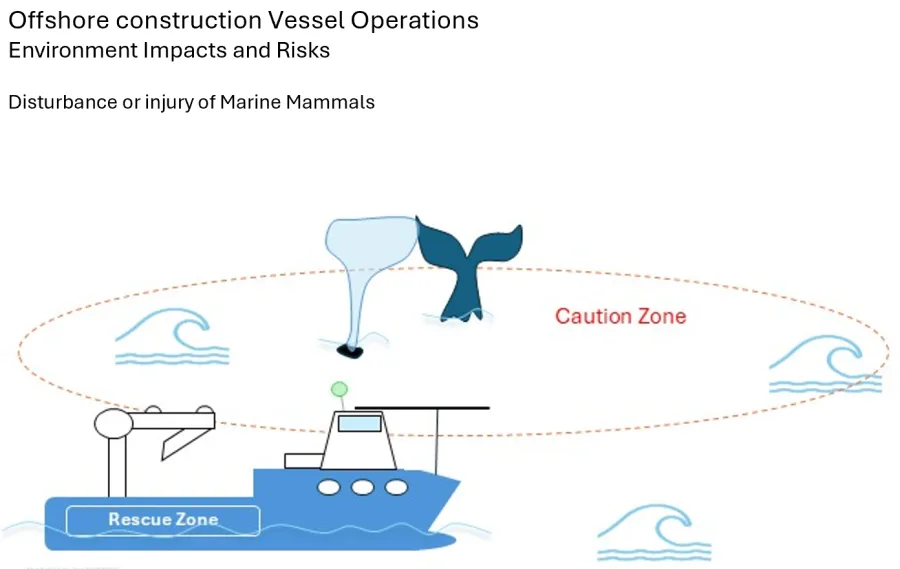
Accidental or uncontrolled hydrocarbon release
Our proposed activities offshore that have the potential to result in accidental hydrocarbon release include:
- Construction vessel operations (collision with other marine users).
- Unplanned release of small quantities of residual hydrocarbons trapped in subsea equipment.
Impact
- Change in water quality
Risks
- Change in habitat
- Change in fauna behaviour
- Injury to fauna
- Changes to the functions, interests, or activities of other marine users
Controls
- Implement a Marine Assurance Process for the vessel to ensure are suitable for the work scope and environmental conditions.
- Implement Marine Exclusion and Caution Zones to ensure other marine users are aware and can avoid the area.
- Ongoing consultation and notification with persons who require it.
- Maintain our capability to respond to a spill of hydrocarbons in accordance with the Oil Pollution Emergency Plan for the activity and associated Operational and Scientific Monitoring Plan.
- Operate in accordance with NOPSEMA accepted Safety Case(s) for the activity.
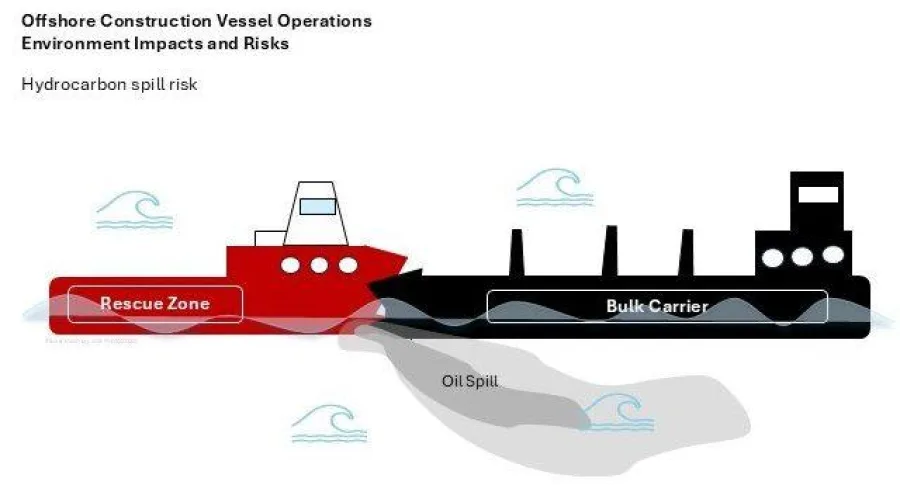
Loss of Materials or Waste Overboard
Our activities that have the potential to result in Loss of Materials or Waste Overboard include:
- Construction vessel operations
- Subsea activities
Risks
- Change in habitat
- Injury to marine fauna
- Disturbance of cultural heritage
Controls
To mitigate or reduce the impacts and risks of our activities we will implement the following controls:
- Marine assurance process for the vessels we hire to ensure they are implementing their Waste Management Plan and that it will prevent the unplanned release of wastes to sea.
- Offshore work procedures to guide the safe recovery of equipment and prevent dropping equipment on the seabed.
- Monitoring of vessel discharges to ensure the Vessel operational discharges are only as prescribed by MARPOL and local regulations.
Have your say
We want to hear from relevant persons. Please use the contact form below to get in touch, and feel free to share this website link with any other relevant persons that you are aware of.
If you contact us via our webform:
We will consider any relevant matters raised during the development of our EP and respond to you.
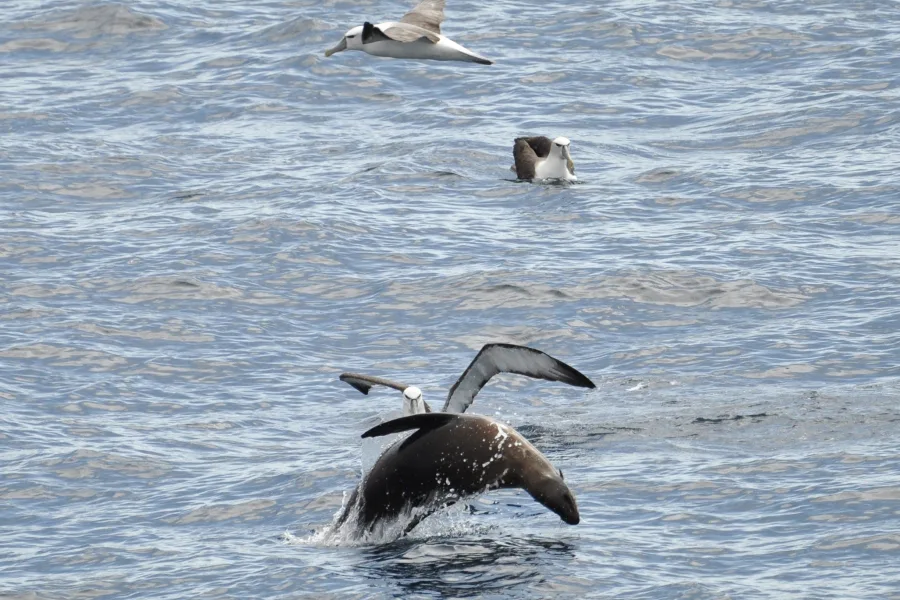
What next
We will submit our draft environment plan to the National Offshore Petroleum Safety and Environmental Management Authority (NOPSEMA) for assessment. If you have consulted with us as a relevant person, your input will be considered in improving our environment plan. Your name will be included in the "sensitive information" section of our plan and not published publicly.
News
Introducing Amplitude Energy
With our new company name we launch a new identity and revised vision for our role in Australia’s energy transition. Domestic gas explorer, producer, employer, innovator.
Information sheet - Summary of Impacts, Risks and Activities
regarding impacts, risks and control measures.
